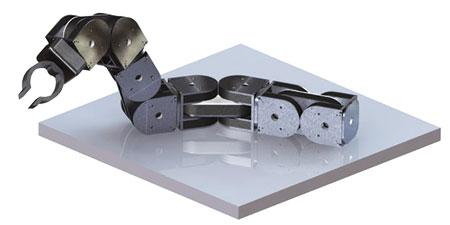September 2011
Several iMobot modules in a snakelike configuration can function as a robotic arm.
Robots make good workers. They perform a routine task time after time with the same precision until they wear out. They are not distracted. Moods do not alter their performance. They can work around the clock. They do not take sick days or vacation.
But they are also not very adaptable.
Traditional robotic designs typically tailor a robot for a specific task. However, in certain situations, there is a need for a multifunctional, adaptable robotic system with autonomic attributes which can be used in an improvisational manner.
Modular robotics research arose out of a need for these more general multi-purpose robotic systems. Modular robots are composed of multiple, linked modules. Although individual modules can move on their own, the greatest advantage of modular systems is their structural reconfigurability. Modules can be combined and assembled to form configurations for specific tasks and then reassembled to suit other tasks.
In long-term space missions, for instance, a robotic system capable of adapting to dynamic situations may greatly enhance the chances of mission success. Furthermore, space missions are typically highly mass and volume constrained. Thus, sending a flexible, adaptable robotic system which can perform many types of tasks is more advantageous than sending several task-specific robots.
Modular robotic systems are also very well suited for dynamic and unpredictable application areas such as search and rescue operations. Modular robots can be reconfigured to suit various situations. For instance a snake-like robot can fit through tight crevices, while a larger walking robot is able to easily navigate over debris.
Quite a number of modular robotic system prototypes have been developed and studied in the past, each containing unique geometries and capabilities. In some systems a module only has one degree of freedom. In order to exhibit practical functionality, multiple interconnected modules are required. Other modular robotic systems use more complicated modules with two or three degrees of freedom. However, in most of these systems, a single module is incapable of certain fundamental locomotive behaviors, such as turning.
To read more click here...
Related Information:

0 comments:
Post a Comment